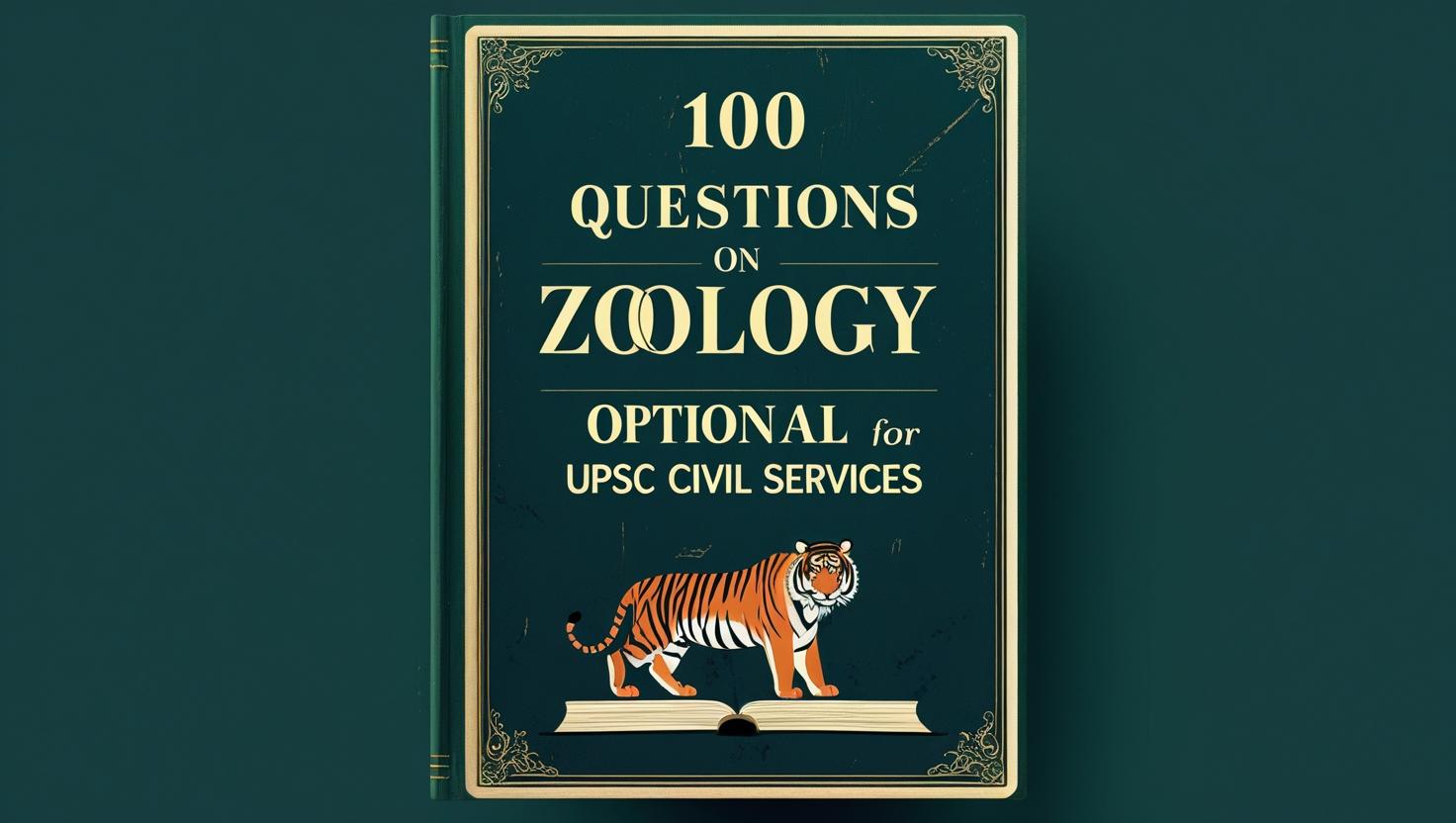Introduction
Zoology is a popular optional subject in the UPSC Civil Services Examination, particularly among candidates with a background in life sciences, medicine, or veterinary sciences. The syllabus covers animal diversity, comparative anatomy, physiology, genetics, biotechnology, evolution, and applied branches of zoology. Practicing previous years’ questions and preparing through topic-wise question banks is crucial for success. Below is a collection of 100 important questions divided into chapters according to the UPSC Zoology syllabus.
For UPSC Coaching , Join FIRST IAS INSTITUTE (India’s Top IAS Coaching)
Chapter 1: Non-Chordata and Chordata
- Describe the canal system and water vascular system in sponges and echinoderms.
- Discuss the affinities and differences between Annelida and Arthropoda.
- Explain the structural organization and economic importance of Mollusca.
- Describe larval forms in crustaceans with examples.
- Explain parasitic adaptations in helminths.
- Write an essay on coral reefs and their significance.
- Discuss the evolutionary significance of hemichordates.
- Compare the nervous system of annelids and arthropods.
- Explain neoteny in urochordates with suitable examples.
- Describe the structure and function of the notochord in chordates.
Chapter 2: Comparative Anatomy of Vertebrates
- Compare the integumentary system of amphibians, reptiles, and mammals.
- Explain the evolution of the heart in vertebrates.
- Describe the jaw suspension mechanisms in vertebrates.
- Discuss the types of scales in fishes and their evolutionary significance.
- Compare the respiratory organs in fishes and amphibians.
- Explain the evolution of the vertebrate kidney.
- Describe the structure and functions of the avian lung.
- Compare the brain of reptiles and mammals.
- Discuss the evolution of paired fins and limbs.
- Explain the adaptive radiation in mammals.
3: Physiology
- Explain the mechanism of muscle contraction.
- Describe the physiology of vision in humans.
- Explain the regulation of heart rate in mammals.
- Discuss the mechanism of blood clotting.
- Explain the role of hemoglobin in oxygen transport.
- Describe the structure and function of the nephron.
- Explain hormonal regulation of the menstrual cycle.
- Discuss the mechanism of hearing in mammals.
- Explain the physiology of digestion in mammals.
- Describe the endocrine functions of the pancreas.

Chapter 4: Embryology
- Explain fertilization in amphibians.
- Describe types of cleavage in animals with examples.
- Discuss gastrulation in birds.
- Explain the structure and functions of extraembryonic membranes in reptiles.
- Describe placental types in mammals.
- Explain the process of metamorphosis in amphibians.
- Describe the role of yolk in vertebrate development.
- Explain organogenesis of the vertebrate heart.
- Discuss experimental embryology in amphibians.
- Explain the significance of stem cells in developmental biology.
Chapter 5: Evolution
- Discuss Lamarckism and Darwinism.
- Explain the modern synthetic theory of evolution.
- Describe isolation mechanisms in speciation.
- Explain the Hardy-Weinberg equilibrium.
- Discuss mimicry and coloration in animals.
- Explain the concept of adaptive radiation with examples.
- Describe the role of fossils in understanding evolution.
- Discuss genetic drift and gene flow.
- Explain the molecular basis of evolution.
- Describe the evolutionary history of the horse.
6: Genetics and Molecular Biology
- Explain Mendelian inheritance with suitable examples.
- Describe linkage and crossing over.
- Explain sex determination in humans and Drosophila.
- Describe mutations and their significance.
- Explain the structure and function of DNA.
- Discuss the operon model of gene regulation.
- Describe RNA types and their roles.
- Explain the process of protein synthesis.
- Discuss recombinant DNA technology.
- Explain applications of genetic engineering in medicine.
Chapter 7: Biotechnology and Immunology
- Explain cloning and its applications.
- Discuss the principle and applications of PCR.
- Explain the role of biotechnology in agriculture.
- Describe monoclonal antibodies and their uses.
- Discuss the immune response in humans.
- Explain the structure and function of antibodies.
- Describe the role of MHC in immunity.
- Explain autoimmune diseases with examples.
- Discuss vaccines and their types.
- Explain applications of biotechnology in forensic science.
Chapter 8: Ecology, Ethology, and Economic Zoology
- Describe ecological pyramids and energy flow.
- Explain the biogeochemical cycles.
- Discuss population dynamics with examples.
- Explain ecological succession.
- Describe the structure and function of ecosystems.
- Discuss animal behavior in relation to learning.
- Explain communication in animals.
- Describe parental care in fishes and amphibians.
- Discuss economic importance of insects.
- Explain the role of vectors in disease transmission.

9: Applied Zoology
- Discuss sericulture and its economic importance.
- Explain apiculture and honey production.
- Describe aquaculture and its significance.
- Discuss the role of livestock in rural economy.
- Explain poultry farming and its benefits.
- Describe fish culture and its applications.
- Discuss integrated pest management.
- Explain the impact of parasites on human health.
- Describe zoonotic diseases with examples.
- Discuss wildlife conservation in India.
Chapter 10: Recent Advances in Zoology
- Explain genetic engineering in animal improvement.
- Discuss stem cell therapy and its potential.
- Explain xenotransplantation and ethical issues.
- Discuss applications of nanotechnology in biology.
- Explain CRISPR-Cas9 technology.
- Describe the Human Genome Project and its significance.
- Explain the concept of DNA fingerprinting.
- Discuss bioremediation and its applications.
- Explain the impact of climate change on biodiversity.
- Discuss ex-situ and in-situ conservation methods.
Conclusion
Zoology as an optional subject in the UPSC Civil Services Examination offers a wide range of topics from classical taxonomy to modern molecular biology and biotechnology. The 100 questions listed above, organized chapter-wise according to the official syllabus, are designed to help aspirants prepare systematically. Practicing these questions will enhance conceptual clarity and improve answer writing skills, which are crucial for securing high marks in Zoology optional.
Also Visit – Best IAS Coaching in India
For Answer Writing Techniques – Join FIRST IAS INSTITUTE

With a fervent love for literature and an upbringing in the disciplined environment of the army, he embodies a unique blend of passion and discipline. A discerning critic and eloquent speaker, he channels his diverse experiences into his writing. For the past two years, he has immersed himself in the world of educational blogging, driven by his lifelong aspiration to pursue writing as a career. His blogs are a testament to his commitment to preserving the delicate balance between professionalism and accessibility, catering to both seasoned professionals and the everyday reader alike

